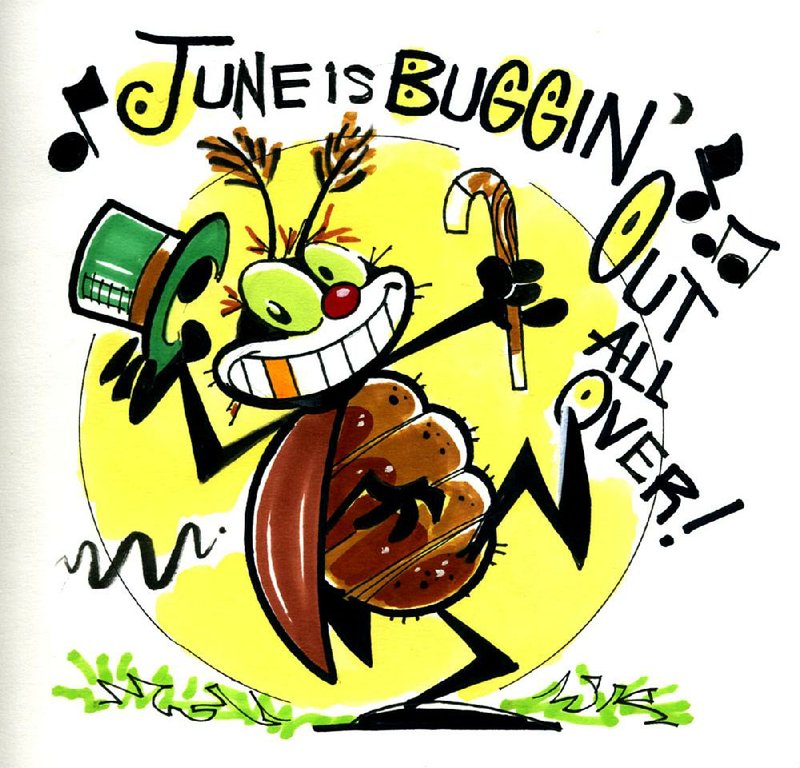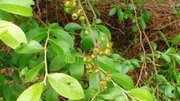Q I noticed that the leaves of two young trees, chinkapin oak and pecan, have been quickly devoured. I looked during the daylight hours and could see no pests. My husband had the idea to look at night. We discovered they were covered in what I have always known as brown hard-shell bugs, the type that swarm around lights. The beetles were chewing leaves and stems.
A You aren't alone. Many folks in central Arkansas have had trees attacked by what many people call June bugs -- these are the adults of the white grubs in the soil. Luckily, they won't be around too much longer, and the damage should be more superficial. There isn't much you can do for them now anyway. If this trend continues for years, then some grub control may be called for.
Q I have oak trees in my yard. This week I notice all of these bugs in my yard. How do I get rid of them? I have lived here more than 30 years and have not had a problem before.
A The insect you are seeing is a periodical cicada. We see some cicadas every year, but we are seeing more this year because of this group. For the past few weeks they have been hatching after spending 13 years underground. For the past few weeks, the adults have been emerging, and you may find holes in the soil where they emerged, and see the empty shells attached to trees where they left their skins behind. You can also hear their mating calls, which at times can be deafening. There can be huge numbers of insects in one yard, and a neighbor may have none. Luckily, these insects only live for about three weeks after they burrow out of the ground. They have a lot to do in a short period of time. After mating with the males, females lay eggs in slits in tree branches. The eggs hatch six to seven weeks later, and the white, antlike nymphs work their way out of the slits and drop to the ground where they enter the soil. Underground, they use their piercing-sucking mouthparts to draw fluid from plant roots for 13 years. The effect of root feeding by the nymph is considered inconsequential to most trees. These periodical cicadas are usually gone completely by the end of June.
Q I have recently had two 65- to 70-foot pine trees removed from our front yard and stumps ground below the surface. Would you please give me suggestions for replacement trees that will not have exposed lateral roots sapping the moisture from my grass lawn? I would like to have attractive specimen, curb-appeal trees not maturing at more than 30 or 40 feet tall?
A While some trees are more prone to surface roots than others, all tree roots compete for moisture. Some well-behaved urban trees include Chinese pistache, gingko, zelkova and European hornbeam.
Q My wife and I have several of these berry bushes growing wild around our property in the Ouachita National Forest. We haven't been able to positively identify what it is. It has blossoms similar to our blueberry bushes; it produces a berry smaller in size and darker blue than our blueberries.
A I believe you have a huckleberry, a close relative to blueberries. These wild blueberries turn almost black when ripe and are totally edible. Some are tart and some are sweet, depending on where they are growing.
Q I have several geraniums, and was wondering if and/or when they should be pruned? I have ivy geraniums and the regular ones. I keep my geraniums in my garage over the winter, and most usually survive and that keeps me from having to buy new ones each year. I live in west central Arkansas.
A If you are keeping them year to year, they are probably getting a bit leggy and woody. Pruning them back when you move them outside should help to prevent this. Pruning now would cut off any blooms. You may want to prune every other branch to keep some color, and when those branches rebound, cut the other half. Next year, when you move them outside, cut them back by one-half or more.
Janet B. Carson is a horticulture specialist for the University of Arkansas Cooperative Extension Service. Write to her at 2301 S. University Ave., Little Rock, Ark. 72204 or email her at
jcarson@arkansasonline.com
HomeStyle on 06/06/2015

